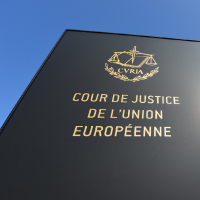
Nowadays, several theoretical perspectives compete for attention in the debate on European integration. Two of these are Intergovernmentalism, developed in 1960s by Stanley Hoffmann and Liberal Intergovernmentalism, developed in the early 1990s by Andrew Moravcsik.
The study of international relations more generally had been dominated, in the post-war period, by the realist model of world politics. The most influential text in post-war international relations Politics Among Nations (Morgenthau 1948), identified a world system in which the dominant actors were rational unitary states, prepared to use force to achieve their goals, and for whom the maintenance of military security lay at the apex of their hierarchy of goals.
From this perspective, cooperative ventures between nation-states were likely only to constitute a temporary equilibrium, from which the partners were at liberty to withdraw should they no longer feel that their interests were best served by membership.
While there have been several criticisms of the realist approach, it is perhaps unsurprising that one of the most powerful early critiques of the neo-functionalist approach to the study of European integration should have had roots in this tradition of thought. While acknowledging the shortcomings of the realist school, not least the fact that states could in no way be characterised as unitary actors, Stanley Hoffmann (1966), in his intergovernmentalist critique of the neo-functionalist approach, developed upon some of the insights of the realist school.
The main criticisms of neo-functionalism were based on its failure to predict the trajectory of European integration (particularly from the 1970s) and its lack of a theoretical core and so its failure to predict and adapt.
Hoffmann emphasised the importance of the international environment and the role, which national governments played within the global system. The role of national governments was to promote the interests of their peoples to the best of their abilities within an adversarial world system. The implications of this for the study of the regional politics (such as the process of the European integration) were important.
First, the importance of regional politics was, according to Hoffmann far less important to national governments than ‘purely local or purely global’ concerns. Within the global international system ‘regional subsystems have only a reduced autonomy’ (Hoffmann 1966:865). Second, Hoffmann highlighted contingent nature of any transnational cooperation. While ‘extensive cooperation is not at all ruled out’, there ‘would be no assurance against a sudden and disastrous reversal’.
For Hoffmann, national governments were more ‘obstinate’ than ‘obsolete’ in the process of European Integration. This was clearly a serious challenge to the snowball effect of cooperation proposed by the neo-functionalist approach.
Hoffmann also drew attention to the ‘limits of the functional method’ or, as he referred to it, the ‘Monnet method’ (Hoffmann 1966:885). Critically, Hoffmann criticised the logic of integration implicit in the ‘Monnet method’, and which Haas had incorporated into his neo-functionalism approach. Hoffmann argued that, in fact, it was the ‘logic of diversity’ which prevailed and which would set limits to the ‘spillover’ anticipated by the neo-functionalists (Hoffmann 1966:882). In areas of vital national interest, Hoffmann argued, national governments were not willing to be compensated for their losses by gains in other areas. Crucially, some issues were more important than others. Instead, national governments would choose to minimise uncertainty and would maintain tight control over decision processes when vital interests were at stake.
Hoffmann’s distinction between issues of ‘low politics’ (economic and welfare policies) and matters of ‘high politics’ (foreign policy, security and defence) was central to his critique of the neo-functionalist approach. The ambiguity implicit in the neo-functionalist ‘logic of integration’ might appear acceptable to national governments when taking decision about tariffs, and almost sufficed for discussions on the issue of agriculture. When it came to the discussion of matters of ‘high politics’, however, clear and consistent goals would be required (Hoffmann 1966:883). National governments would not be persuaded to accept anything less.
The “classical” intergovernmentalism has been developed recently to the more complex theoretical concept, Liberal Intergovernmentalism of Moravcsik. It constitutes a counter-balance to the supranational tendency in the European integration theory such as neo-functionalism. The core elements of his theory are the rational state behaviour, the liberal theory of national preference formation and the intergovernmental interpretation of the interstate relations.
This theory considers the European Union as an intergovernmental organisation limited to the collective pursuit of those tasks which protect and enhance the sovereign authority of its member states. It focuses, firstly, upon the member states and how they interact with one another in the Council of Ministers and secondly, upon the ‘grand bargains’ made in Treaty form.
Liberal Intergovernmentalism focuses on a series of treaties between member states, which have been the watersheds of the European integration process. These treaties constitute the explanatory variable for the existence and outputs of the European political system.
Moravcsik, drawing on the insights of realist and inter-governmentalist approaches, argued that interstate bargains between Britain, France and Germany were the key determinants of the negotiation of the SEA. Moreover, the bargains struck represented the LCD (Lowest common Denominator) solution, achievable only because of the convergence of national interests. Each government had closely guarded its national sovereignty and had placed strict limits on any further transfer of sovereignty (Moravcsik 1991:46-8). He differentiated his ‘intergovernmental institutionalism’ by stressing the importance of ‘domestic politics’ in influencing the changing interests of states (Moravcsik 1991:48).
Moravcsik developed his argument with his work on Liberal Intergovernmentalism, he argued that ‘state behaviour reflects the rational actions of governments constrained at home by domestic societal pressures and abroad by their strategic environment’. The preferences of national governments, which determine their positions in international negotiations, are determined, he argued, by domestic societal forces: ‘the identity of important societal groups, the nature of their interests and their relative influence on domestic policy’. Within the framework of Liberal Intergovernmentalism, however, Moravcsik allowed for a degree of what he termed ‘agency slack’. Thus, within the principal-agent relationship, in which societal principals delegate power to governmental agents, there is occasionally some limited discretion allowed to those agents. Where the interests of societal groups are ambiguous or divided, the constraints upon government are loosened: allowing politicians ‘a wider range of de facto choice in the negotiating strategies and positions’.
National governments have not, he argued, simply passively enjoyed the benefits of the occasional discretion allowed to them by divided or unclear domestic pressures. They have actively sought to maximise their room for manoeuvre. Thus, Moravcsik has argued that national governments have used EU institutions as part of a two-level game to increase the policy autonomy of national governments in relation to domestic interests: ‘particularly where domestic interests are weak or divided, EC institutions have been deliberately designed to assist national governments in overcoming domestic opposition’. Thus, far from supranational elites tying member states into a process to which they are resistant, the European Union may in fact strengthen the state by allowing, for example, chief executives to ‘manipulate their own domestic constituents into accepting common policies’.
Moravcsik later has refined and developed his liberal inter-governmentalist perspective. Central to his argument remains the belief that European integration is best explained ‘as a series of rational choices made by national leaders’. Moravcsik’s tripartite explanation for the process of European integration concludes: that national preferences are best explained by economic interests, that the outcome of interstate bargains is best explained by the relative power of the states involved and finally that the decision to delegate powers to EU institutions is taken because it is the most effective way of ensuring the credibility of commitments from other member states.
Theorists advocating Liberal Intergovernmentalism, consider state as the crucial actor in the European integration process. The preferences and power of the member states are what determine outcomes. Furthermore, Liberal Intergovernmentalism offers a good prediction of the final outcome of the negotiations.
There are though critics such as Peterson, who concluded that no single theory could explain EU governance at all levels of analysis. Broad ‘macro’ approaches to the issue of integration (such as Liberal Intergovernmentalism) were particularly useful for explaining the major ‘history-making’ decisions of the EU. When it came to explaining ‘policy-setting’ or ‘policy-shaping decisions, however, ‘macro-theories tend to lose their explanatory power’.
Garretti and Tsebelis in their Institutional Critique of Intergovernmentalism, pointed out that this theory overestimates the influence of governments holding extreme preferences and underestimates that that of more centrist governments. Additionally, power index analysis fails to consider the important roles of the Commission and the European Communities and European Parliament in legislative processes. Today’s procedures affect the mix of agenda-setting and veto power and this has systematic effects on policy outcomes.
Among those criticising Liberal Intergovernmentalism was also Marlene Wind, who said that ‘important institutional elements such as the evolution and change of norms, ideas and historically produced codes of conducts-discursive as well as behavioural- are completely expelled from analysis. She, as well, criticised Moravcsik for underestimating the role of the Commission and personalities.
Having in mind all this critiques about Liberal Intergovernmentalism and about other theories of integration it can be concluded that the theoretical debate about how to explain European integration continues.
It should be concluded that member states are appropriately the central actors in the European Union, but the role of the Institutions must not be underestimated. It would be very important to point out that the European integration is clearly more than one thing, and much of the theoretical confusion generated in attempts to explain it has stemmed from theorists’ insistence that it has been a single, ‘complex’ phenomenon.













